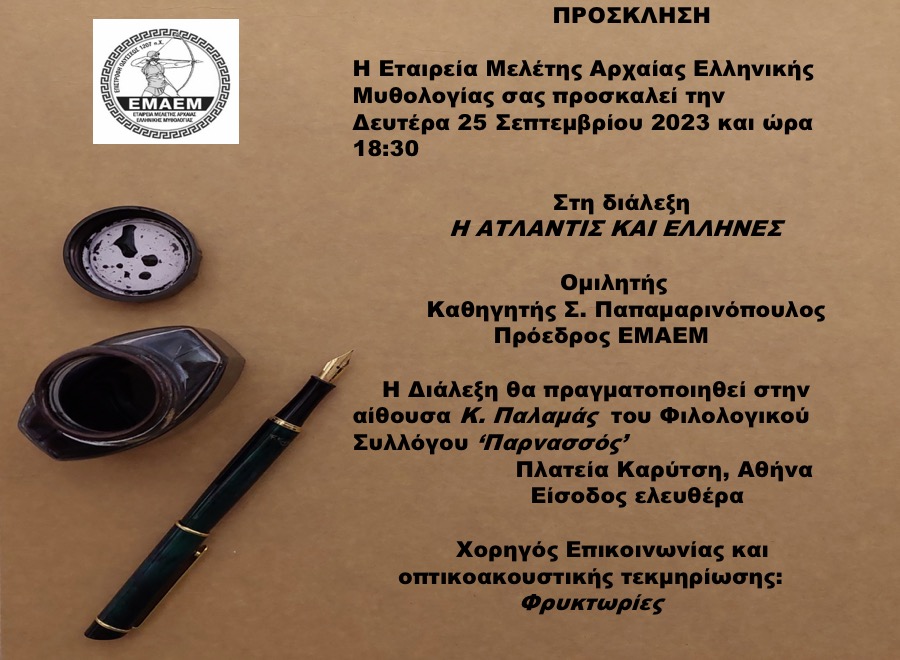Lecturer: Stavros Papamarinopoulos
(President of EMAEM)
Monday 25 September 2023, 6.30-8.30pm
Literary Society "Parnassos"
(Palamas Hall),
Karytsi Square, Athens
Abstract
Atlantis’ position is in the Atlantic Ocean. Its position is placed by the platonic text with exactitude. Its geomorphologic nature is defined by the meaning of the word nesos not with that, of the 4th century BC in which Plato lived, but by the concept which corresponded in remote period centuries earlier. Then, the word had five different meanings as Homer says. With the word Atlantis is, presented, initially, a system of ring like homocentric craters altered by land and sea circular zones. In addition Atlantis is a horseshoe type flat valley which is surrounded by mountains in the North, West and East but not in the South where it ends in the Atlantic Ocean. Further the valley’s axis is directed in South-North direction. Atlantis is also a vast land. The nature of the concentric craters, and with warm waters, corresponds with a mud volcano whereas the red, white and black stones which were the building material of Atlantis’s houses were products of the local geology west of the pillars of Heracles in south Spain. In this region there are numerous mad volcanoes and not magma volcanoes. Atlantis, whose name is Plato’s arbitrary choice, was destroyed by huge repetitive earthquakes and successive tsunamis. Recently in Gadiz Heracles’ enormous temple has been found in less than 4 m water depth. Strabo and Poseidonious date the temple in 1100 BC. Plato’s narration about Atlantis’s opponent, Athens, has nothing to do with the 4th century BC. It corresponds with Athens of the end of the 13th and early 12th century BC as the results of excavations propose. Plato mentioned some of the Kings of Athens. In fact all the Kings of Athens, Κekrops, Erysichthon, Kranaos, Erichthonios, Pandion, Erechtheus, Kekrops, Pandion, Aegeus, Theseus, Menestheus, seem to drop within the second millennium BC! Archaeologist S. Marinatos wrote that the Atlanteans, meaning the Sea Peoples, met the strong Achaeans in an unknown place. The contact had occurred between 1218 and 1207 BC. They got very tired from the contact and then they entered exhausted in the Nile and they were crashed by the Egyptians. The end of Atlantis occurred in 1150 BC by an extreme event, meaning, repetitive earthquakes and subsequent repetitive tsunamis. Atlantis was prehistoric Tartessos which was destroyed violently and it was not lost quietly as the next Tartessos from Guadalquivir’s river deposits. Both prehistoric Tartessos and prehistoric Athens got seismic catastrophes from different causes within the late 13th century BC and early 12th century BC respectively.
Curriculum vitae – Stavros Papamarinopoulos
Stavros Papamarinopoulos originates from Arkadia. His mother Dimitra Dimitrakopoulou is from Tegea and his father Panos Papamarinopoulos is from Karytaena in Arcadia Peoloponesos. He has a degree in Physics from the University of Athens and a Ph.D in Geophysics from the University of Edinburgh. As member of the Department of Geology of the University of Patras at the level of the Professor delivered systematic lectures to Geology and Physics students in Patras, Mining Engineers at the Athens Polytechnic and Archaeologists at the University of Athens. He has got the Academy of Athens price for the discovery of King Xerxes’ Canal which was dug in East Khalkidhiki Peninsula which was mentioned in detail by Herodotus and he located the subterranean Eridanos River in Syntagma Square in Athens. He has conducted 300 geophysical projects in Greece, Britain, France, Spain, Russia, Central Asia in the Altai Plateau, North East and North West Africa attempting to locate buried ancient cities.
He was member of the National Consul of Research and Technology (2004-2010). He is member of the European and American Geophysical Unions respectively. He is founding member of the Hellenic Society of Archaeometry, founding member of the Society for the Study of the Ancient Hellenic Mythology and chairman of it. He is Visiting Professor of Sorbonne University. He has published tens of scientific studies after reviewing and he has hundreds of citations from them.
He applied and received funding by the European Community. It was the first for the country in 1981 in connection with geophysical data obtained by a helicopter over a mixed sulphide ore deposit. Contract no MPP 151 GR, Proposal no 10.002, N. Greece: 7.000.000 drachmas. Funding body EC, Directorate General, R and D Programme Indirect Action (1978-1981)


